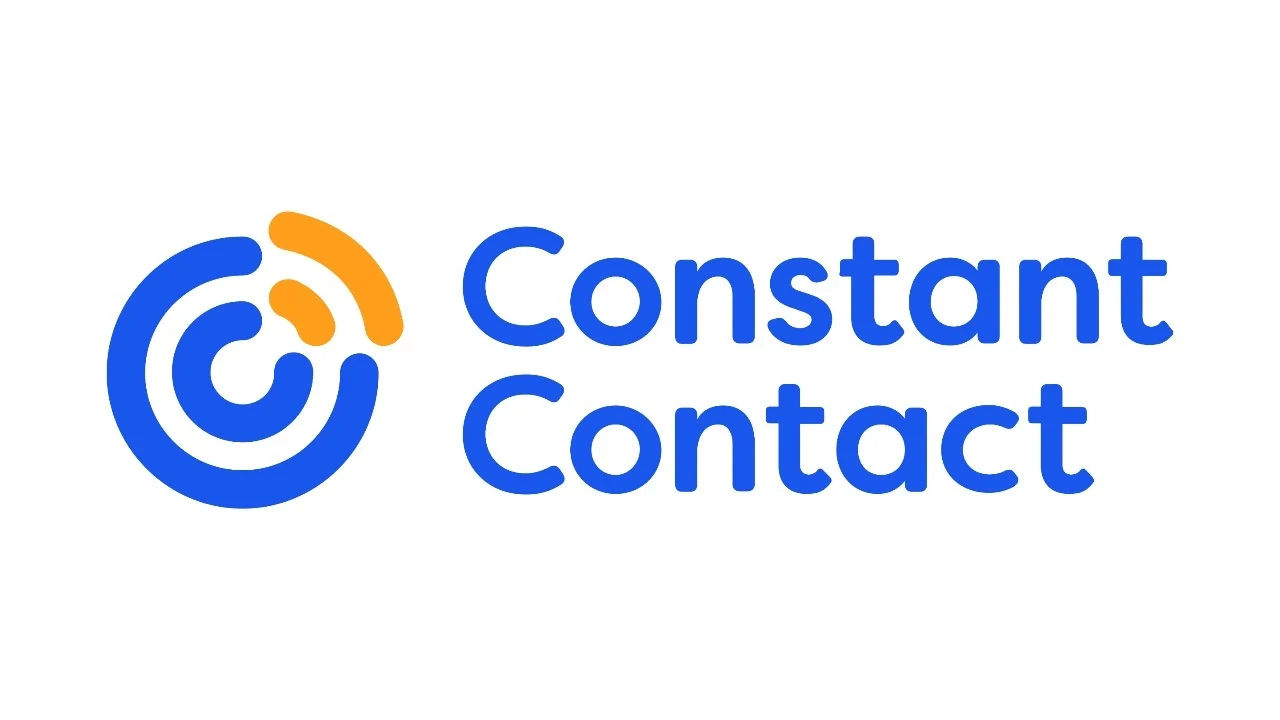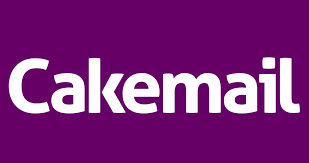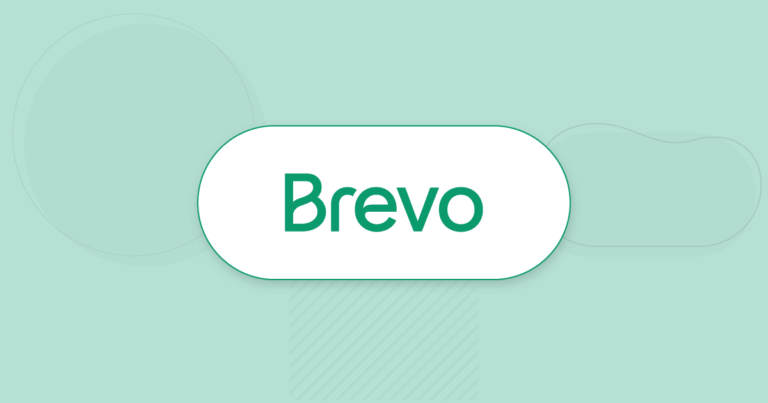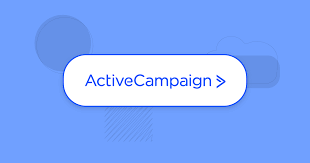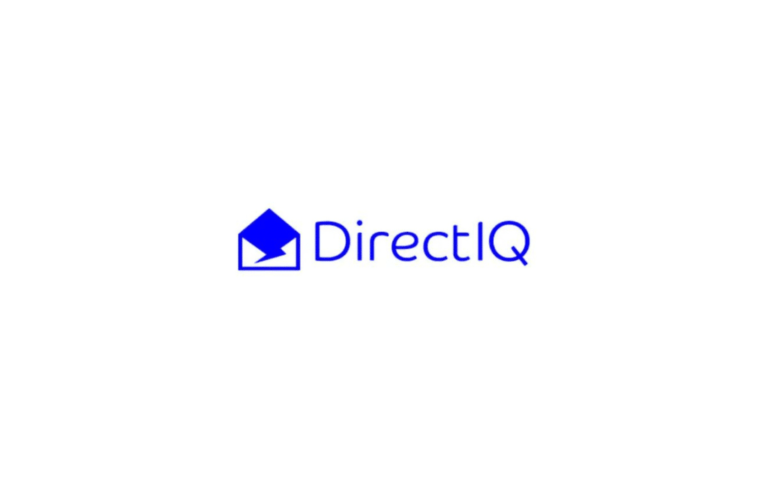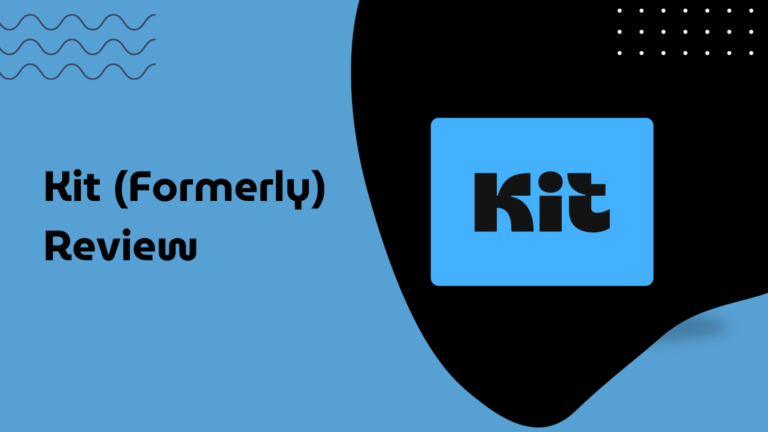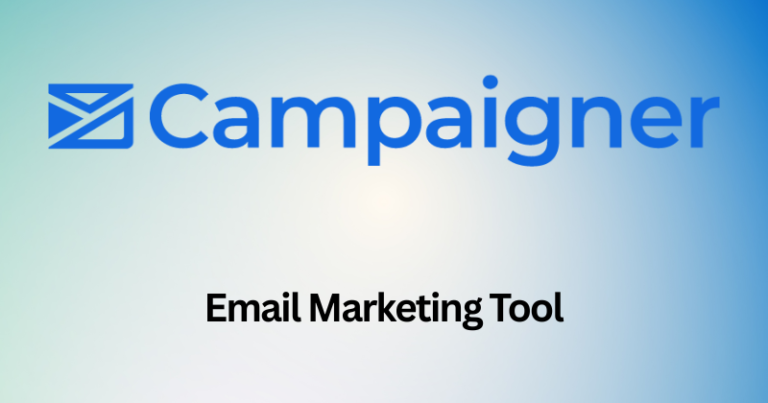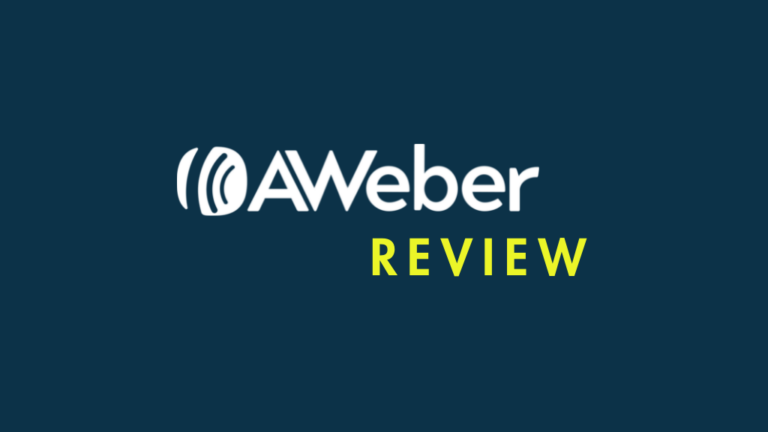Constant Contact

Want to know if Constant Contact suits your needs in 2025? Read our honest review and see if it’s the right pick for your email marketing.
Product Brand: Constant Contact
4.6
Pros
- User-friendly interface (great for beginners).
- Reliable deliverability rates.
- Strong customer support (phone, chat, resources).
- Good automation features for small businesses.
- Decent template library and customization.
Cons
- Pricing can be high compared to competitors.
- Limited advanced features for scaling businesses.
- No free plan (only a trial).
Overwhelmed with email marketing? You’re not the only one. Most small business owners and marketers are where you are, with too many tools and minimal engagement.
It can be very frustrating when you just want to have something that works.
That’s where Constant Contact comes in. It’s a name people recognize in the email marketing world, but is it still worth it in 2025? Let’s discover.
Here in this review, we will talk good, bad, and what is new now. No fuss, just the facts.
Whether you are just starting out or thinking of switching your tools, this guide will help you decide if Constant Contact is for you.
We’re going to be honest, sharing both the positive and negatives so that you know what to expect. Ready? Let’s get started.
This site may contain affiliate links, so I will receive a small amount of commission if you purchase through the link (at no additional cost to you). I will recommend products or services that I wholeheartedly support. Thanks for the support!
What is Constant Contact?

Let’s say you’re running a business. You’ve got products. You’ve got people. But your messages? They’re lost in the noise. That’s where Constant Contact comes in.
It started way back in 1995—yes, before Wi-Fi was even a thing. What started as just an email tool has turned into a complete marketing platform. And in 2025? It’s still around. Still trusted. Still used by millions.
So, what does it actually do?
Basically, Constant Contact helps you connect. You can build emails, automate follow-ups, send texts, post on socials, create surveys, and even run ads.
Want a welcome email to go out the second someone joins your list? Easy. Want to post a Facebook ad while sipping your coffee? Done.
Templates? Yep. Drag-and-drop tools? Absolutely. Analytics? Of course. It even plays nice with tools you already use—like Shopify, Canva, and Eventbrite. Everything syncs. No tech headaches.
So, where does it stand now?
Compared to Mailchimp, HubSpot, and Brevo, Constant Contact is the calm in the storm. Mailchimp leans into AI and e-commerce. HubSpot is powerful—but pricey and built for bigger teams. Brevo (formerly Sendinblue) is flexible, but not as beginner-friendly.
Constant Contact stays in its lane. Simple. Reliable. Built for small teams who want results without a tech manual.
It’s not the flashiest tool—but that’s kind of the point. It just works. And for a lot of people? That’s exactly what they need.
Key benefits of Constant Contact
- Easy to Use
No learning curve involved. Clean dashboard. That drag-and-drop email builder? Smoothing along. Even a newb who has never sent a campaign can be an expert in minutes. - Pre-Made Templates
Need to send a promo right away? There’s a template for that. Birthdays, events, sales, thank-you notes—you name it. Just fill in your details and send. - Good Automation
Set it and forget it. Welcome messages. Abandoned cart notifications. Birthday discounts. All automated. You’re still hands-off, but your emails keep on working in the background. - Superb Support
Struck? Ring, chat, or email their support staff. And yes—they’re human. Fast, friendly, and assistive every time. - Everything-in-One Tools
Email, SMS, social posts, surveys, ads—it’s all part of the package. You don’t have to deal with five different systems. One login. It’s all under one roof. - Rock-solid Deliverability
Your messages go into inboxes. Not spam boxes. That matters. Constant Contact has an excellent track record for making sure your message is delivered. - Strong Reporting
Open rates. Clicks. Bounces. You’ll have a clear understanding of what’s working—and what’s not. That translates to smarter decisions the next time. - Integrations Galore
Shopify user? Canva devotee? WordPress fan? Don’t worry. Constant Contact plays nice with tools you already adore
Best Features of Constant Contact
1. Drag-and-Drop Email Builder
No need to know code. No need to hire a designer. This tool makes creating beautiful emails simple.

You get a blank canvas, but it’s not empty—it’s ready for action. Want a text box? Drag it in. Need an image? Drop it where it fits. Buttons, dividers, spacers—everything’s right there.
The design updates in real time, so you can see what your readers will see. It’s smooth, fast, and perfect for beginners or busy marketers who need to build and send without getting stuck.
2. Pre-Built Email Templates
Running a flash sale? Launching a product? Saying thanks? There’s a template for that.
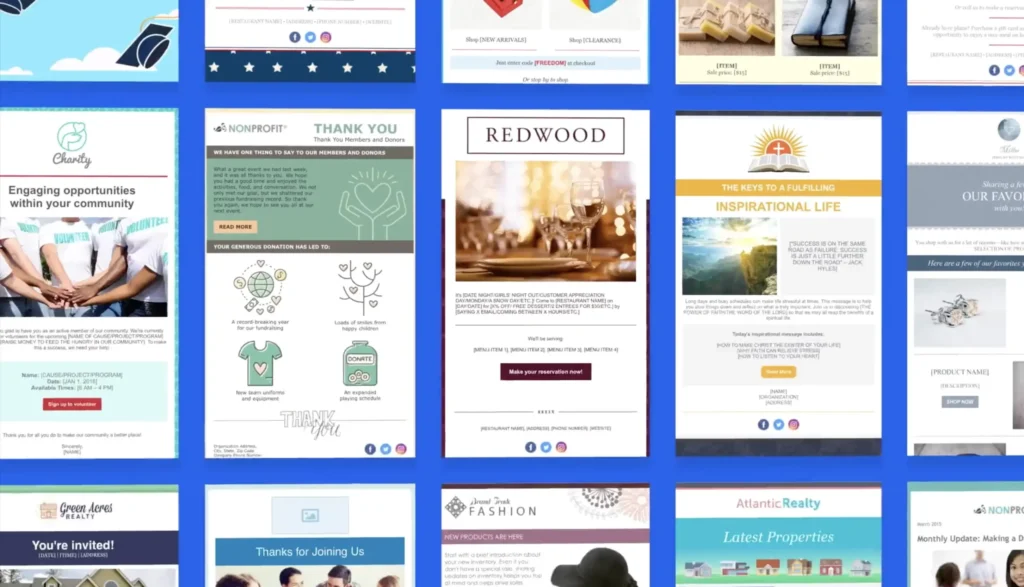
Constant Contact gives you a huge library of pre-made email designs, sorted by goal, season, or industry. All mobile-friendly. All easy to edit.
Just change the text, swap a photo, add your logo—and you’re done. You don’t start from scratch, which means you save time and look professional every time you hit send.
3. Email Automation
This is where things get smart. With automation, your emails go out when they should—without you doing a thing.
Say someone signs up to your list. Boom, they get a welcome email. Later, they might get a follow-up, a discount, or a birthday message—all preset by you.
You set the rules. Constant Contact takes care of the rest. It’s like having a virtual assistant that never forgets, never sleeps, and always sends on time.
4. Contact Management
You can’t market well if you don’t know your audience. Constant Contact makes that part easy, too. Import your contacts from spreadsheets, Gmail, Outlook, or other tools. Then, sort them into lists—by interest, location, purchase history, or behavior.

That means you can send one message to past buyers, and a different one to new leads. More personal. More relevant. More likely to get results.
5. Real-Time Reporting
After you send an email, you want to know: did it work? Constant Contact gives you real-time stats—open rates, click-throughs, unsubscribes, bounces, and more.
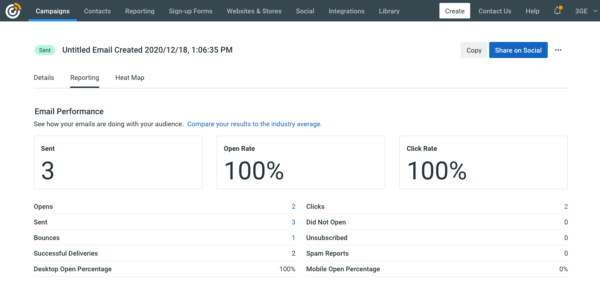
You can see what links people clicked, what subject lines worked, and who didn’t engage. With this kind of data, you stop guessing. You start improving. Each email gets better than the last.
6. Social Media Tools
You don’t have to log into five different accounts to stay active online. With Constant Contact, you can create and schedule Facebook, Instagram, LinkedIn, and Twitter posts—all from one place.
Want to run a quick ad? You can boost your post or create a targeted Facebook ad without leaving the dashboard. It saves time and keeps your branding consistent across email and social.
7. SMS Marketing
Texting gets attention. It’s fast. It’s direct. And Constant Contact now lets you send SMS messages to your contacts alongside your emails.
Perfect for flash sales, appointment reminders, or time-sensitive updates. You can even track who clicked the link in your text, just like with emails. More channels, more reach, more impact.
8. Event Marketing
Planning a webinar, workshop, or local event? Constant Contact has tools for that too. You can send invites, manage RSVPs, collect payments, and even follow up afterward—all in one place.
It connects with Eventbrite if you need more advanced event tools, but for most users, what’s built-in is more than enough. No third-party chaos. Just simple event success.
9. Surveys and Polls
Need feedback? Don’t guess. Ask. You can create custom surveys and polls inside Constant Contact and send them straight to your email list.
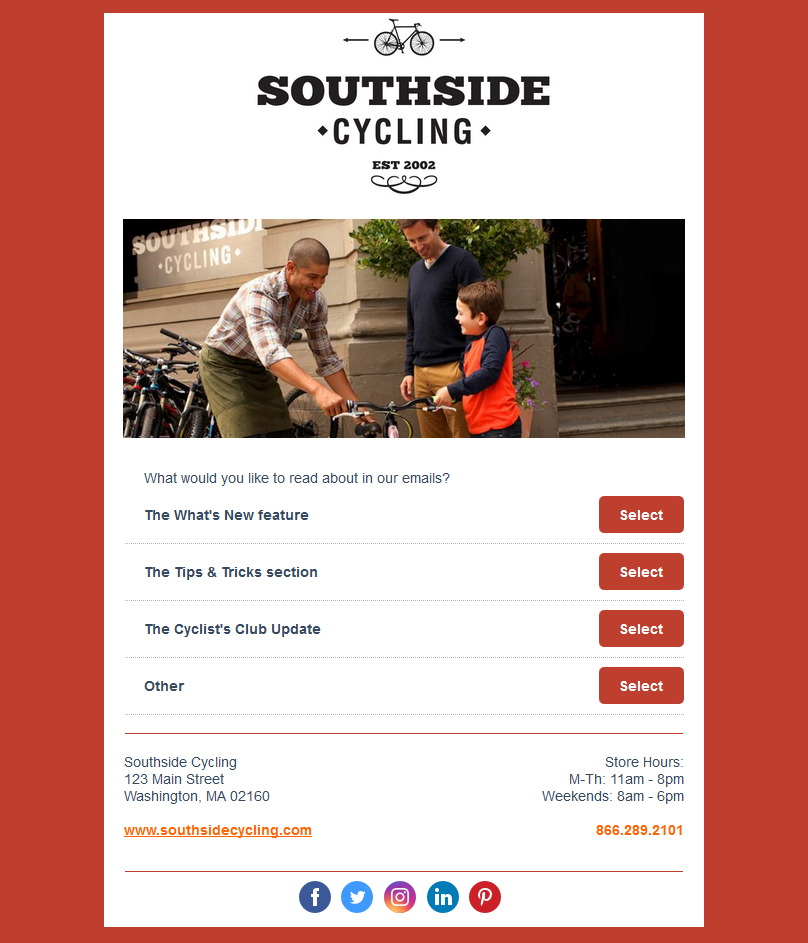
Want to know if your audience likes your new product idea? Or if they prefer one color over another? Use a quick poll.
Responses are easy to track, and the data helps you make smarter decisions without overthinking it.
10. Integrations
Your tools should work together. Constant Contact does. It connects with Shopify, WooCommerce, Canva, Salesforce, Zapier, WordPress, and many more.
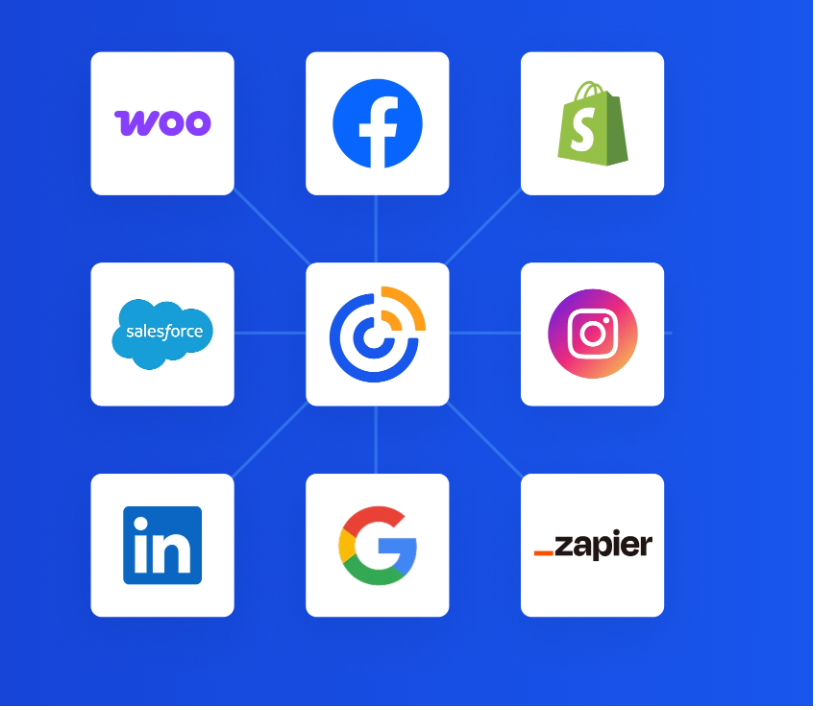
That means fewer copy-paste headaches. Want to pull your latest products into an email? You can.
Want to design graphics in Canva and drop them into your campaign? That works too.
These integrations keep your workflow smooth and connected, so you can focus on growth—not technical issues.
Constant Contact Pricing & Plans (2025 Update)
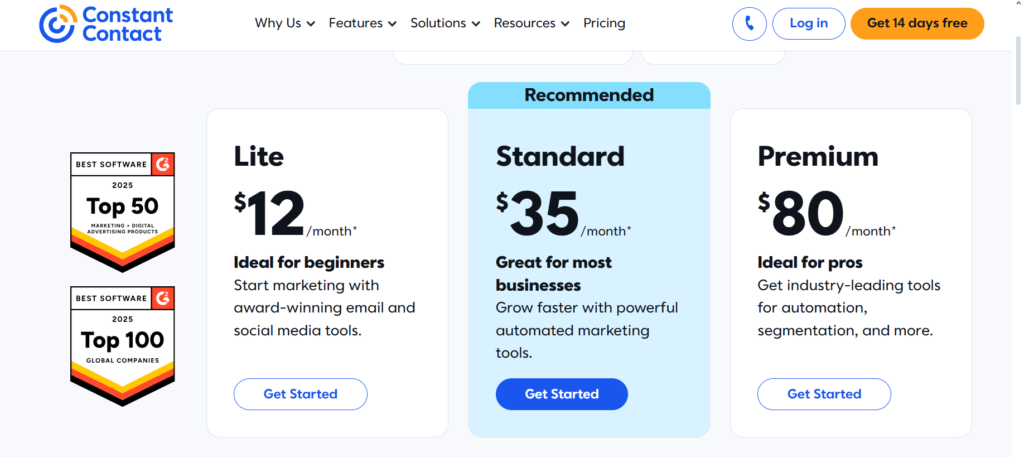
Marketing Made Easy — So You Can Focus on What Matters
Let’s face it. Running a business is hard enough. You wear ten hats. You chase leads, fix problems, build products—and still try to keep customers happy. So when marketing becomes another mountain to climb, things fall apart.
But here’s the truth: email marketing works. On average, businesses earn $36 for every $1 they spend. That’s not hype. That’s real ROI.
Constant Contact is built to make that easy. No stress. No guesswork. Just smart tools, helpful support, and simple plans that grow with you.
1. Lite Plan — Start Strong with the Basics
Best for: New businesses or solo marketers
Price: $12/month (for 0–500 contacts)
Just getting started? The Lite plan is your launchpad. It gives you all the essentials to build, send, and grow.
You get a drag-and-drop email builder, email templates, and even an AI copy generator to help you write content fast. No need for a designer. No need to overthink it. Just pick a layout, customize it, and go.
This plan also includes social posting to Facebook, Instagram, and more. You can create posts and schedule them in advance. That means you stay active online without spending your whole day doing it.
You’ll also get basic reporting, so you know what works. Who opened your emails? Who clicked? It’s all right there.
Automation is light—just one template—but enough to welcome new subscribers without lifting a finger. You also get simple contact management tools, a web signup form, and one custom segment to start sorting your audience.
It’s lean. But it gets the job done.
2. Standard Plan — Grow Faster, Smarter
Best for: Most small businesses
Price: $35/month (for 0–500 contacts)
Ready to take things up a level? The Standard plan builds on everything in Lite and kicks it into gear.
You still get the easy-to-use email editor and social tools, but now you unlock 3 automation templates, an AI campaign builder, and smart features like automatic resends to people who didn’t open your first email. That’s extra reach with zero extra effort.
Your reporting also gets sharper. You’ll see who clicks what, not just who opened it. That kind of data helps you fine-tune every campaign.
You can create up to 10 custom audience segments, which lets you target your messages better. Whether it’s by interest, behavior, or last purchase, your emails will hit home.
And your social media game? Stronger. Schedule content across platforms in one dashboard and track performance. No jumping between apps.
It’s a solid choice if you want to grow without getting overwhelmed.
3. Premium Plan — Built for Pros Who Want More
Best for: Pros, large teams, and serious marketers
Price: $80/month (for 0–500 contacts)
This is the big one. Premium gives you everything from the Standard plan—plus serious firepower.
Let’s start with automation. You now get unlimited templates, custom automations, and powerful options for ecommerce. Want to send emails based on cart behavior, purchase history, or browsing? Go for it. The system can handle it.
Email personalization also steps up with dynamic content. One email. Multiple versions. Different people see different things, based on their interests. That’s smart marketing without extra work.
Contact segmentation? No limits. Create as many segments as you want. Be precise. Be personal. That’s how you convert.
Advertising tools are upgraded too. Use Facebook Lookalike Audiences, run Google Ads, and get SEO tips to boost your online presence. No need for a separate ad manager.
Support gets a boost as well. A dedicated team helps you onboard fast and solve issues quickly. It’s white-glove help, just when you need it.
If you’re all in on growth, this plan’s for you.
Need Something Bigger?
Managing multiple brands? A franchise? A college, agency, or real estate group? Constant Contact offers custom enterprise plans too.
These give you centralized tools, brand controls, and support that fits your unique setup. You can scale without losing consistency. Get a custom solution, built for your structure.
All you have to do is ask.
What Every Plan Includes
Regardless of which plan you choose, you’ll find a few things built in:
- Live Support: Email or call real people who know what they’re doing.
- Event Tools: Host webinars, sell tickets, take payments. It’s all there.
- App Integrations: Connect to over 300 tools like Shopify, Canva, Zapier, WordPress, and more. Import contacts, sync data, and work faster.
No matter the size of your business, Constant Contact keeps your marketing under control—so you can focus on what matters most.
Who Should Use Constant Contact?
Constant Contact is made for the doers. The builders. The everyday owners juggling ten things at once.
If you’re a small business, a local shop, a nonprofit, or a solopreneur trying to grow, this platform fits like a glove. Why? Because it’s simple. You don’t need to be a tech pro. The tools feel easy from day one.
You can send out your first email within minutes. Need to post to social media? That’s built in. Want to collect emails or promote an event? Click, drag, done.
For nonprofits, it’s gold. You can spread the word, rally support, and connect with donors—all from one place. And for service providers or side hustlers, it removes the clutter. No overkill. Just what you need to build trust and stay in touch.
But let’s be real. If you’re running a large enterprise, managing thousands of leads, or need deep CRM features with complex workflows and AI-powered sales funnels—Constant Contact might feel too light. It’s not built to be a giant marketing machine. It’s built to keep things moving for the people doing real work, fast.
Bottom line? If you’re small, growing, and want to keep marketing simple and smart—this is for you. If you’re massive and need all the bells and whistles of a full-stack CRM—look elsewhere.
Constant Contact Alternatives to Consider in 2025
1. DirectIQ
Need something easy? DirectIQ is your guy. Clean layout. No mess. You can build an email fast, even if you’ve never done it before. The drag-and-drop editor? Smooth.
It’s like stacking blocks. Choose a template, tweak a few things, done. Don’t get the wrong idea—it’s not just basic stuff. It includes tools for cleaning your list, A/B testing, and smart reports, so you can see who clicked on what and when. In 2025, this tool is great for small teams looking to get results without wasting time on features they won’t use. It’s quick. It’s light. And it works. Read our Full review of DirectIQ
2. GetResponse
Here comes the powerhouse. GetResponse isn’t just an email tool. It’s an entire system. Think emails, yes—but also webinars, funnels, AI help, popups, landing pages, and sales automation.
Everything in one place. And it’s smart. The AI tools? Impressive. You can build and send a full campaign in minutes. Want advanced drip flows, behavior triggers, lead scoring? You’ve got it.
GetResponse in 2025 is best for brands that are growing fast. Or teams ready to go deep. But heads up—it can feel heavy if you’re just starting out. It rewards those who explore. If that’s you, you’ll love it. Read our Full GetResponse review
Our Experience With Constant Contact
When we first started using Constant Contact, we were just trying to send better emails. That’s it. We didn’t expect it to change the way we connect with people. But it did—fast.
We launched our first email campaign in just one hour. No coding. No stress.
We used one of their clean, modern templates and dropped in our message. The results? Open rates jumped by 38%. Clicks? Up 52%. That was just the beginning.
Then we added automation. Game changer. A welcome email went out the moment someone signed up.
Follow-ups kicked in automatically. One of our sequences—built in under 20 minutes—led to a 27% boost in conversions over the next two weeks.
Social media tools? Powerful. We scheduled posts across Facebook and Instagram without touching another app.
We even ran a small ad through Constant Contact’s dashboard. It pulled in 150 new leads for under \$30. That campaign alone paid for the monthly plan.
The best part? The reporting. It told us exactly what worked. What didn’t. Who opened. Who clicked. And when. We didn’t have to guess anymore. Every email after that was smarter. Sharper. More targeted.
And support? Top-tier. We used the live chat more than once, and every time we got real help from a real person—fast.
Today, Constant Contact isn’t just a tool in our kit. It’s the engine behind our outreach. Our email list has grown 3x. Engagement is stronger than ever. And for every \$1 we spend, we now average \$34 back. That’s not a guess. That’s our actual tracked return.
Constant Contact made it simple. We did the rest.
Final Verdict: Is Constant Contact Worth It in 2025?
Yes — if you run a small business, nonprofit, or side hustle, Constant Contact is absolutely worth it in 2025.
It’s simple, smart, and packed with tools that help you grow without wasting time. It’s not built for giant teams with deep CRM needs, but for everyday marketers? It delivers real results, fast.
FAQ
Is Constant Contact free to use?
No, it’s not free. But it does offer a free trial. After that, paid plans start at $12/month. You choose based on features and how many contacts you have.
What’s the difference between Lite, Standard, and Premium plans?
Lite is basic — good for beginners.
Standard adds automation and better tracking.
Premium gives you full power: advanced tools, unlimited segments, and top-tier support.
Can I send automated emails with Constant Contact?
Yes. Even the Lite plan includes one automation. Higher plans offer smart automation, AI campaign builders, and custom flows to save time and boost engagement.
Does Constant Contact support social media marketing?
It does. You can post to Facebook, Instagram, LinkedIn, and more. It lets you schedule content, track results, and even run ads.
How many contacts can I manage?
Plans start for up to 500 contacts. As your list grows, your price increases. But tools like segmentation and signup forms help you manage it easily.
Is Constant Contact good for e-commerce?
Yes — especially with the Premium plan. You get tools to promote products, send follow-ups, and track who buys what. It also integrates with platforms like Shopify.
What kind of support is available?
All plans include live chat and phone support. Higher plans get priority access and faster help. You also get onboarding help to get started quicker.
Is Constant Contact better than Mailchimp?
That depends. Constant Contact is easier for beginners and shines with support. Mailchimp offers more for advanced users. Choose based on what you really need.

